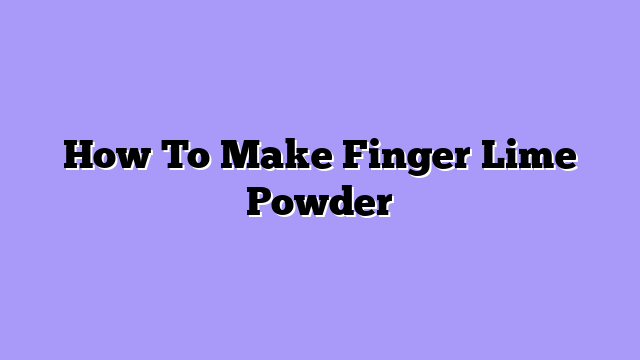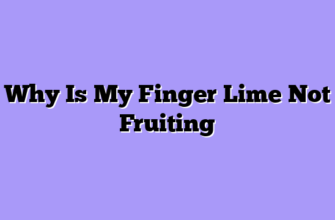You know that moment when you bite into a finger lime and those tiny pearls explode on your tongue like nature’s pop rocks? Well, imagine capturing that intensity and concentrating it into a powder that packs ten times the punch. That’s exactly what finger lime powder does, and after twelve years of perfecting this process on my exotic fruit farm, I’m about to share the secrets that transformed my seasonal surplus into year-round profit.
Let me tell you, the first time I made finger lime powder was pure accident. It was 2018, and I had a bumper crop that was ripening faster than I could sell it. Rather than watch my precious citrus caviar go to waste, I started experimenting with preservation methods. What began as desperate salvage operation became my most profitable value-added product.
The journey wasn’t smooth sailing, though. My first attempts produced what I generously called “expensive green dust” – flavorless, bitter, and about as appealing as sawdust. But persistence pays off in farming, and after countless batches of trial and error, I cracked the code. Now, restaurants across three states pay premium prices for my finger lime powder, and home chefs guard their supplies like precious treasure.
The Art of Selection: Not All Finger Limes Are Created Equal
Here’s something most people don’t realize – making exceptional finger lime powder starts long before you fire up the dehydrator. It begins with selecting the right fruit, and trust me, this is where amateurs separate from professionals.
I’ve learned that timing is absolutely everything. You want finger limes that are just past peak ripeness – not the pristine specimens you’d serve fresh, but the ones that are slightly soft and have developed their full flavor profile. Think of it like choosing wine grapes; you’re not looking for the prettiest, you’re hunting for maximum flavor concentration.

Color variation actually works in your favor when making powder. While restaurants prefer uniform green finger limes for fresh service, powder-making allows you to blend different varieties for complex flavor profiles. My signature blend combines the tartness of green finger limes with the floral notes of pink varieties and the robust citrus punch of the red champagne cultivar.
Key selection criteria for powder-making finger limes:
- Slightly overripe but not moldy or damaged
- Full color development (deeper pigments equal stronger flavors)
- Firm vesicles that haven’t started breaking down
- No signs of pest damage or disease
- Harvested during dry weather (moisture content affects drying time)
The Dehydration Dance: Temperature, Time, and Technique
Now comes the technical part, and this is where most people mess up. Finger lime powder isn’t just dried fruit run through a grinder – it’s a carefully orchestrated process that requires precision timing and temperature control. Get it wrong, and you’ll end up with expensive compost.
I use a combination approach that took me three years to perfect. First, I extract the pearls from the skin using a technique I developed that maximizes yield while minimizing bitter pith contamination. Here’s my step-by-step process:
- Initial preparation: Wash finger limes in cool water and pat completely dry
- Pearl extraction: Cut fruits lengthwise and gently squeeze pearls into stainless steel bowls
- Cleaning phase: Remove any white pith or skin fragments using tweezers
- Pre-dehydration treatment: Light salt rinse to draw out excess moisture
- Primary drying: Dehydrator at 115°F for 18-24 hours until pearls are crispy
- Secondary drying: Oven finish at lowest setting (170°F) for 2-3 hours
- Grinding phase: High-speed spice grinder in small batches
- Sifting and storage: Fine mesh sieve, then airtight containers with desiccant packets
The temperature control is absolutely critical here. Too hot, and you’ll destroy the delicate essential oils that give finger limes their distinctive flavor. Too cool, and you risk bacterial growth or incomplete dehydration. I learned this lesson the hard way when my first commercial batch spoiled because I tried to rush the process.
Humidity plays a massive role too. I only make powder during our dry season now, typically late fall through early spring when ambient humidity stays below 50%. During summer months, even with perfect dehydrator settings, the high humidity interferes with proper drying and creates clumpy, inferior powder.
| Drying Stage | Temperature | Duration | Key Indicators |
|---|---|---|---|
| Initial Extract | Room temp | 30 minutes | Pearls separate cleanly |
| Pre-treatment | Room temp | 15 minutes | Light surface moisture removal |
| Primary Dry | 115°F | 18-24 hours | Pearls sound hollow when tapped |
| Secondary Dry | 170°F | 2-3 hours | Completely crispy, no flex |
| Grinding | Room temp | 5-10 minutes | Fine, consistent powder |
From Powder to Profit: Uses That Will Blow Your Mind
Here’s where things get exciting. Finger lime powder isn’t just a novelty – it’s a culinary game-changer that opens up possibilities fresh finger limes simply can’t match. The concentration process intensifies the flavor by roughly 800%, creating what I like to call “citrus MSG” – a natural flavor enhancer that transforms ordinary dishes into extraordinary experiences.
My restaurant clients use it in ways that still surprise me. One chef in Portland rims cocktail glasses with finger lime powder mixed with sea salt – the result is like a margarita that explodes in your mouth. Another incorporates it into chocolate truffles, creating this incredible sweet-tart contrast that keeps customers coming back for more.
But the real money-maker has been the spice blend market. I create custom finger lime powder blends for high-end seasoning companies, combining it with complementary spices like sumac, pink peppercorns, and dried herbs. One blend I developed for a gourmet company now generates more revenue than my fresh fruit sales.
The home cooking applications are endless too. Try mixing finger lime powder with butter for an instant citrus compound that elevates everything from grilled fish to roasted vegetables. Sprinkle it on fresh fruit salads for an intensity boost that makes regular citrus seem boring. I even use it in my morning smoothies – just a pinch transforms the entire flavor profile.
Storage and shelf life were initially concerns, but proper technique solves both issues. Correctly made finger lime powder stored in airtight containers with oxygen absorbers maintains potency for up to two years. Compare that to fresh finger limes that last maybe two weeks in optimal conditions, and you can see why powder has become my insurance policy against market fluctuations.
The economics are compelling too. A pound of fresh finger limes might sell for $80-120 at farmers markets. That same pound, converted to powder, yields about 2-3 ounces of finished product that sells for $15-20 per half-ounce. Do the math – you’re looking at potentially quadrupling your revenue while creating a shelf-stable product that ships easily nationwide.
The Learning Curve: Mistakes That Made Me Better
Let me share some hard-won wisdom from my failures, because trust me, there were plenty. My biggest mistake early on was trying to scale up too quickly. I went from making small test batches to attempting five-pound production runs without understanding how batch size affects drying time and quality. The result was inconsistent powder with varying potency levels that frustrated customers and nearly killed my reputation.
Another costly lesson involved storage. I initially used regular mason jars, thinking they were airtight enough. Wrong. Finger lime powder is incredibly hygroscopic – it absorbs moisture from the air like a sponge. Within six months, my “premium” powder had turned into expensive green clumps that looked more like moldy cheese than gourmet seasoning.

Quality control became essential as demand grew. I now test every batch for moisture content, particle size consistency, and flavor intensity. It sounds obsessive, but when you’re charging premium prices, your product needs to deliver premium results every single time.
The beauty of finger lime powder lies in its versatility and intensity. It’s taken my farm from seasonal cash flow struggles to year-round profitability, and it can do the same for other exotic fruit growers willing to invest the time to master the process. The key is patience, precision, and never settling for “good enough” when “exceptional” is within reach.
Remember, in the specialty food world, consistency breeds loyalty. Master this process, and you’ll have customers who become evangelists for your product. That’s worth more than any marketing budget could ever buy.








